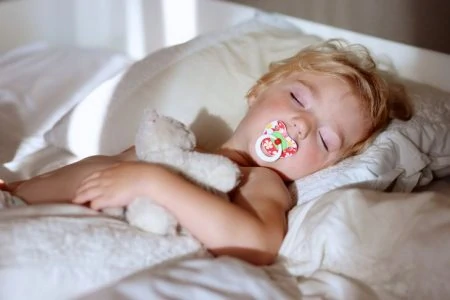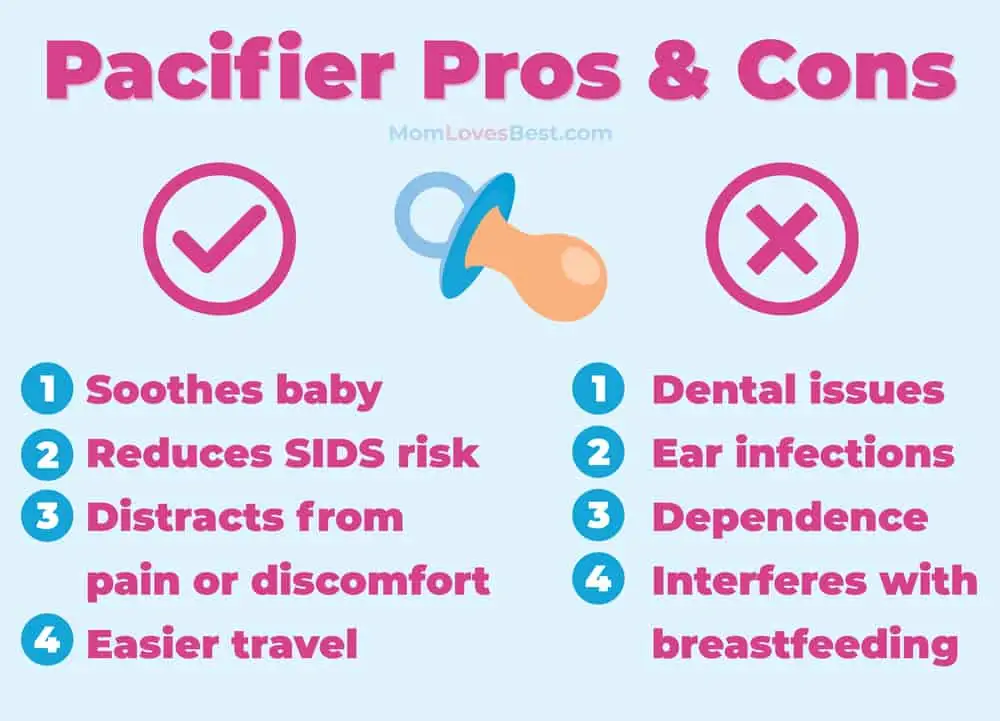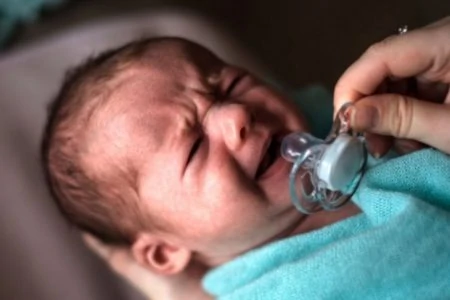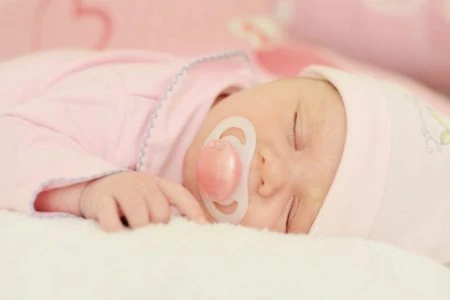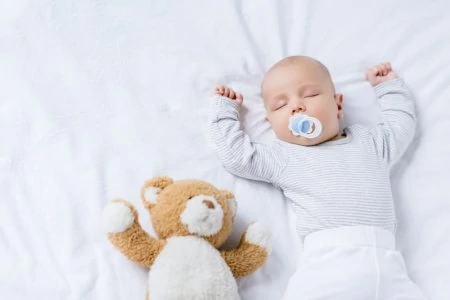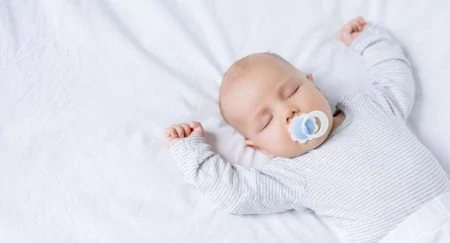But eventually, the pacifier stops being helpful and becomes a hard habit to break. While some kids ditch the dummy on their own between ages 2 and 4, others need a gentle push to say farewell.
We have been there with our own reluctant toddlers, so we know the struggle is real. We did the research to find gentle, tear-free solutions for you. In this guide, we will break down the pros and cons, the perfect timing for weaning, and seven simple steps to help your child let go of the binky for good.
Key Takeaways
- Pacifiers satisfy the natural sucking reflex in infants, provide comfort during sleep, and may reduce the risk of SIDS in newborns.
- Prolonged use past age 2 or 3 can lead to dental misalignment, “pacifier teeth,” and potential speech delays.
- The ideal weaning window is often between 6 and 12 months to prevent emotional attachment, or definitively by age 2 to protect oral development.
- Gradual weaning strategies involve limiting use to crib-only times, using transitional objects, and positive reinforcement.
Pros of Using a Pacifier
Pacifiers do a lot of heavy lifting in the early months. They satisfy that intense sucking instinct, offer a distraction during shots or blood tests, and help your baby settle down for sleep.
Perhaps the biggest medical benefit is the link to safety. Studies show pacifiers can reduce the risk of sudden infant death syndrome (SIDS) when used at naptime and bedtime for babies between 1 month and 6 months old. The sucking motion helps keep the baby in a lighter stage of sleep, which reduces the chance they will stop breathing (1).
Risks of Continued Pacifier Use
While the binky is a hero in the newborn stage, it becomes a villain as your child grows. Eventually, the risks begin to outweigh the temporary silence.
Ear Infections
After 6 months, babies who constantly suck on pacifiers have a higher rate of middle ear infections. Doctors believe the continuous sucking motion changes the pressure in the ears. This prevents fluid from draining through the eustachian tubes, leading to fluid buildup and infection.
Dental Issues
This is the big one most parents worry about. If a child uses a pacifier past age 2, their jaw grows around the object held in their mouth.
The American Academy of Pediatrics (AAP) and the American Dental Association (ADA) warn that overuse leads to improper mouth development. This includes “pacifier teeth,” where the top front teeth tip forward and the bottom teeth tip back. It can also reshape the roof of the mouth (2). If your toddler is still using one, mention it to your dentist so they can monitor their bite.
Speech Delays
Talking requires practice. If a toddler has a plug in their mouth all day, they aren’t babbling or experimenting with sounds.
Long-term use can also distort speech. It forces the tongue and lip muscles to develop unnaturally, which might lead to a lisp or trouble articulating certain sounds later on.
The Best Time to Stop Using a Pacifier
There is a “sweet spot” for weaning that saves you headaches down the road.
Between 6 and 12 Months:
The AAP suggests weaning during this window is ideal. At this age, the sucking reflex diminishes, and the pacifier becomes more of a habit than a biological need. Weaning now also lowers the risk of ear infections (3). Plus, if you wean before they start to crawl or walk, they cannot chase you around the house begging for it.
By Age 1:
Stopping by the first birthday helps avoid speech delays during a critical language explosion period.
By Age 2 (The Hard Limit):
To avoid permanent “pacifier teeth,” you really want to be done by age 2 (4).
If you miss these windows and are struggling with a toddler, ensure you switch to an “orthodontic friendly” pacifier. These have a flattened bottom and rounded top to mimic a mother’s nipple, putting less pressure on the developing gums and palate.
How to Wean Off the Pacifier
Ready to take the plunge? Help your child ditch the habit with minimal tantrums and tears by following these seven proven steps.
1. Timing is Everything
Never start weaning during a major life transition. If you are starting daycare, welcoming a new sibling, potty training, or moving to a new house, keep the binky for now.
Your child needs their coping mechanism during stressful events. Wait until life settles down before taking it away.
2. Limit the Usage
Go for a gradual fade-out. Start by making a rule that the pacifier stays in the crib. It doesn’t go to the park, the store, or the living room.
Once they accept that, limit it strictly to naptime and bedtime. Eventually, remove it from naptime. Nighttime is usually the hardest hurdle, so tackle that last. You might need to ramp up the bedtime routine with a warm bath, extra bedtime books, or lullabies to fill the void.
3. Offer a Transitional Object
Your child likely uses the pacifier to lower their heart rate and relax. You need to replace that tool with something else.
Introduce a “lovey” or security object. This could be a special stuffed animal or a soft security blanket. Encouraging them to hug their lovey when they are sad teaches them a new way to self-soothe.
4. Don’t Cave During Meltdowns
This is the hardest part for parents. When your toddler is screaming, it is so easy to plug the hole to get some peace. Try to resist.
Check the basics first: are they hungry, wet, or tired? If they are just upset, try distraction. Sing a song, look out the window, or grab a toy. Keep their hands and minds busy so they forget about the craving.
5. Use Praise, Not Punishment
Toddlers respond beautifully to positive reinforcement. When they go a whole morning without asking for the binky, make a big deal out of it.
Tell them, “You’re such a big kid!” or “I’m so proud of you!” Use a sticker chart or offer small rewards like play dough time.
Keep It Positive
6. Make it Unappealing
If logic and bribery aren’t working, you can try sabotage. Some parents dip the pacifier in white vinegar or lemon juice.
The shock of the sour taste usually makes the child spit it out immediately. If the binky tastes gross, they won’t want it.
Safety Warning
7. The Farewell Ceremony
For older toddlers, a ritual works wonders. Make it a celebration of growing up.
You can have the “Binky Fairy” come to collect all the pacifiers and leave a cool toy in exchange. Or, take your child to the toy store and let them “pay” for a new toy using their bag of pacifiers.
Alternative: Going Cold Turkey
Some parents prefer to rip the Band-Aid off. This requires nerves of steel, but it is fast.
Explain that pacifiers are for babies and they are big kids now. Pack them all up in a box and “mail” them to a new baby (you can actually just toss them).
Expect A Rough Week
Expert Tips From Real Moms
Every child is different, but these mom-tested tricks might save your sanity:
- Out of sight, out of mind: Don’t leave pacifiers on the counter. If they don’t see them, they might not think to ask for them.
- Read a special book: Books help kids process big changes. Try titles like “Bye-Bye Binky,” “Pacifiers are Not Forever,” or “Bea Gives Up Her Pacifier.” reading these daily prepares them for the big day.
- Give yourself grace: This is stressful for you, too. If you have a bad day and cave in, don’t beat yourself up. Just start fresh the next morning.
- Stay confident: You are the parent. Your child takes their emotional cues from you. If you are calm and confident that they don’t need it, they will eventually believe you.
FAQs
Bye-Bye Binky!
Weaning your child from the pacifier is one of those parenting milestones that feels impossible until it’s done. It might be sticky and loud for a few days, but protecting their smile and speech is worth the effort.
Whether you choose the slow fade or the cold turkey method, trust your gut. You know your child best. If you are hitting a wall, don’t hesitate to ask your pediatrician or pediatric dentist for backup. You’ve got this!
